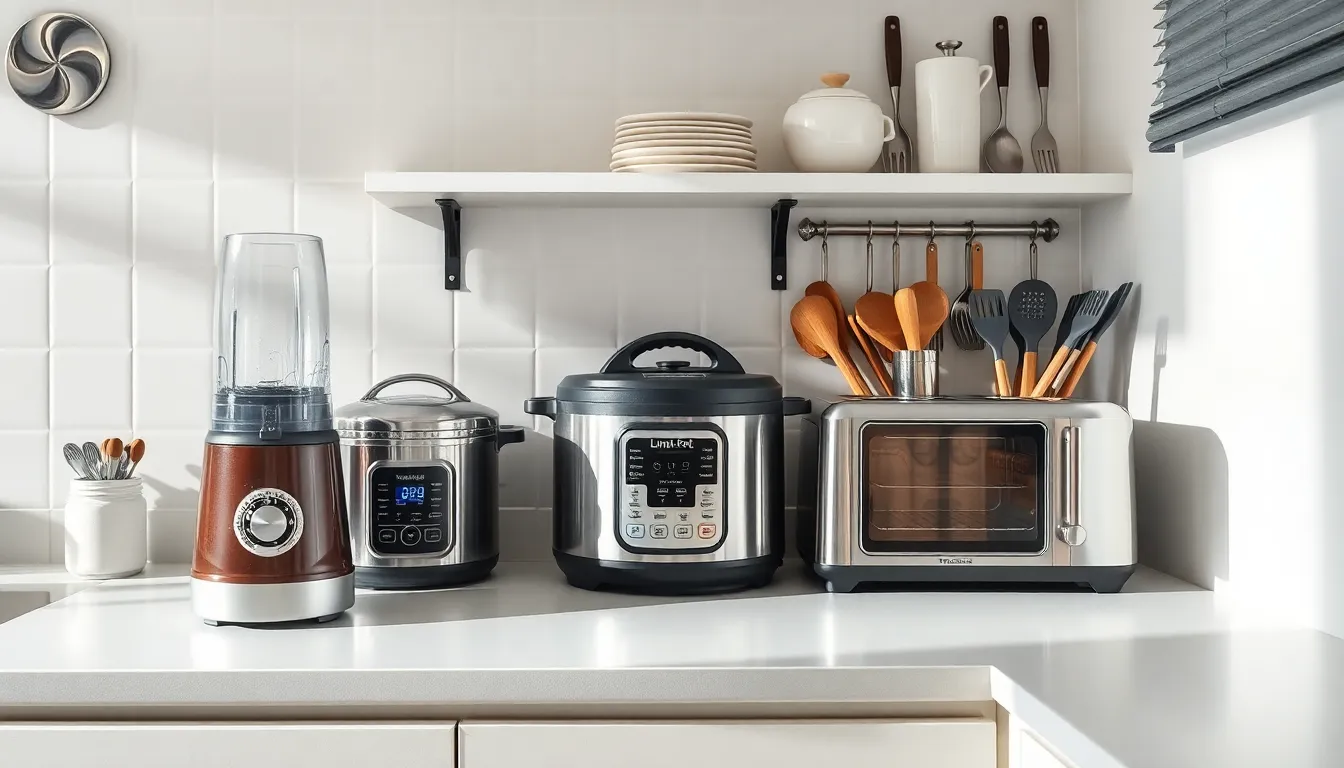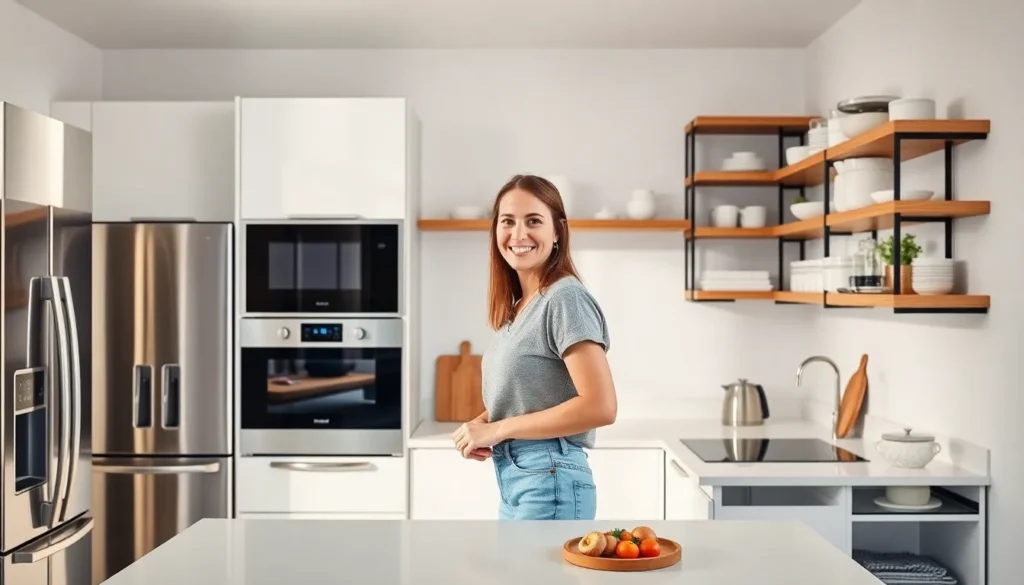In today’s fast-paced world, a minimalist kitchen can be a breath of fresh air. It’s not just about aesthetics; it’s about creating a functional space that enhances cooking and dining experiences. By embracing simplicity, one can transform cluttered countertops and overflowing cabinets into streamlined areas that promote creativity and ease.
Minimalist kitchen tips focus on selecting essential items, maximizing storage, and prioritizing quality over quantity. With a few strategic changes, anyone can enjoy a serene cooking environment that inspires culinary adventures. Whether you’re a seasoned chef or a home cook, adopting minimalist principles can revolutionize how you interact with your kitchen.
Essential Minimalist Kitchen Tips
Minimalist kitchens thrive on functionality and simplicity. Implementing the following tips helps create a serene cooking environment.
Declutter Your Kitchen Space
Decluttering is the first step toward a minimalist kitchen. Start by assessing all items and removing duplicates. Place seldom-used appliances, utensils, and gadgets in storage, keeping only the essentials visible. Donate or recycle items that don’t serve a purpose. A clutter-free countertop enhances both aesthetics and efficiency, making meal preparation smoother.
Organize With Purpose
Organization boosts functionality in a minimalist kitchen. Group like items together, such as pots, pans, and utensils. Utilize storage solutions that maximize space, including pull-out shelves and drawer organizers. Label containers for easy identification. Prioritize accessible essentials, ensuring that daily-use items remain within reach. This strategic approach fosters an environment conducive to creativity and ease during cooking.
Choosing The Right Tools

Selecting the right tools is crucial for achieving a minimalist kitchen. Essential items should enhance functionality and streamline cooking processes.
Multi-Functional Appliances
Multi-functional appliances save space while offering diverse capabilities. Examples include:
- Blender/Food Processor: Blend smoothies, chop vegetables, and puree soups with one tool.
- Pressure Cooker/Slow Cooker: Cook meals quickly or let dishes simmer for hours with a single device.
- Toaster Oven/Air Fryer: Toast bread, bake, and air fry foods without needing multiple appliances.
Investing in these versatile appliances reduces clutter and simplifies meal preparation.
Quality Over Quantity
Prioritizing quality ensures long-lasting kitchen tools that perform effectively. Focus on:
- Durable Materials: Choose stainless steel and tempered glass for utensils and cookware, minimizing replacements.
- Brand Reputation: Select brands known for reliability, ensuring performance and longevity.
- Essential Items: Limit purchases to high-quality knives, pots, and pans that meet specific cooking needs, rather than numerous lower-quality options.
By emphasizing quality, a minimalist kitchen remains functional and efficient over time, supporting everyday cooking tasks without unnecessary distractions.
Design Considerations
Design plays a crucial role in establishing a minimalist kitchen. It balances aesthetics with functionality, focusing on simplicity and practicality.
Color Palette and Materials
Choosing a cohesive color palette enhances a minimalist kitchen’s serenity. Neutral tones like white, gray, and beige create an airy feel, while accents in muted colors or natural materials add warmth. Selecting high-quality materials, such as stainless steel, bamboo, or natural stone, contributes to longevity and cleanliness. These choices not only promote elegance but also simplify maintenance, as they resist stains and scratches, making the space practical.
Layout Efficiency
Efficient layout maximizes functionality in a minimalist kitchen. The kitchen work triangle—comprising the stove, sink, and refrigerator—ensures a seamless workflow. Placing these elements within an ideal distance of 4 to 9 feet promotes efficient movement. Open shelving or cabinets with glass fronts can maintain visual openness while providing necessary storage. Keeping similar items within close reach reduces clutter and enhances the user experience, fostering a fluid cooking environment. Positioning frequently used utensils and appliances within arm’s reach streamlines meal preparation, ensuring that essential tools are accessible without hindering the space’s clean look.
Maintenance and Upkeep
Maintaining a minimalist kitchen requires strategic cleaning and storage practices. These practices ensure an organized and efficient cooking environment.
Simplifying Cleaning Routines
Simplifying cleaning routines contributes to a practical minimalist kitchen.
- Daily Quick Clean: Perform a quick clean daily by wiping surfaces and washing dishes right after use. This prevents build-up and ensures a tidy space.
- Use Multi-Functional Cleaners: Opt for versatile cleaners that tackle multiple surfaces, reducing the number of products needed and simplifying storage.
- Routine Deep Cleaning: Schedule weekly deep cleaning sessions to address less frequent tasks such as scrubbing floors and organizing cabinets. Sticking to a routine maintains overall cleanliness and efficiency.
- Utilize Containers: Store cleaning supplies in designated containers underneath the sink. This keeps essentials organized and easily accessible while maintaining a clean aesthetic.
Long-Term Storage Solutions
Effective long-term storage solutions enhance the functionality of a minimalist kitchen.
- Labeling Systems: Implement clear labeling on storage containers and shelves, helping to easily identify contents and ensuring proper organization.
- Vertical Storage: Utilize vertical space with wall-mounted shelves or hooks for pots and pans. This maximizes storage without cluttering counter space.
- Under-Bed Storage: Use under-bed storage bins for seasonal or rarely used kitchen items. This strategy frees up cabinet space while keeping seldom-used tools accessible.
- Stackable Containers: Invest in stackable, airtight containers for dry goods. This method saves space and keeps ingredients fresh, minimizing waste and preserving essentials.
- Drawer Dividers: Incorporate drawer dividers to categorize utensils and tools. This method simplifies finding items quickly, promoting an efficient cooking experience.
Embracing a minimalist kitchen can transform not only the space but also the cooking experience. By focusing on essential items and maintaining an organized environment, individuals can foster creativity and efficiency in meal preparation.
The thoughtful selection of tools and a cohesive design approach contribute to both functionality and aesthetic appeal. Regular maintenance and strategic storage practices ensure that the kitchen remains a serene and inviting space.
Ultimately, adopting these minimalist principles allows anyone to enjoy a more enjoyable cooking journey while simplifying their daily routines.













